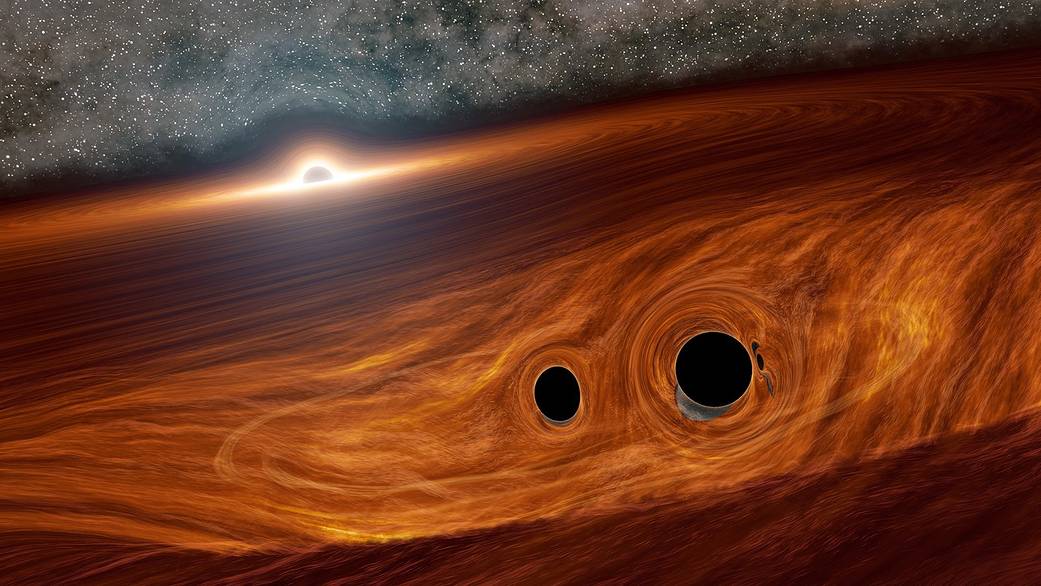Black holes may have existed since the beginning of time (and could explain dark matter mystery)
Primordial black holes could explain more than one astronomical mystery.

The nature and origin of black holes and their role in the evolution of the universe still puzzles scientists. Now, a new study suggests that the existence of black holes from the earliest moments of the universe could explain more than one astronomical mystery.
The new study suggests that small primordial black holes filled the early universe right after the Big Bang, acting as an accelerator of star and galaxy formation. This theory by itself is not new, as it was proposed by Stephen Hawking in 1971. In the new study, however, a team of astronomers shows how the existence of such primordial black holes neatly fills some major gaps in the current understanding of the universe.
First, these black holes could explain the existence and nature of dark matter, the invisible stuff that, according to estimates, makes up some 85% of all matter in the universe. How do they do that? Simply, these black holes could themselves be that never before observed dark matter, the evidence for which has so far failed to materialize, despite the fact that the universe as we understand it cannot exist without it.
Related: Astronomers peer deeper into Milky Way's heart than ever before in new images
"Our study shows that without introducing new particles or new physics, we can solve mysteries of modern cosmology from the nature of dark matter itself to the origin of supermassive black holes," Nico Cappelluti, assistant professor in physics at the University of Miami and co-author of the new study, said in a statement.
The theory of primordial black holes, originally proposed by Hawking, was later abandoned for the current dominant view of black holes being born after massive stars collapse at the end of their lives.
But observations and detections of black holes enabled in the past years with sophisticated technology show that the black holes lurking around in the universe don't always match expectations. Some black holes seem too big, others too small, for what would be possible if they had all formed just from collapsing massive stars.
Get the Space.com Newsletter
Breaking space news, the latest updates on rocket launches, skywatching events and more!
"Black holes of different sizes are still a mystery," Günther Hasinger, science director at the European Space Agency (ESA) and also a co-author of the paper, said in the statement. "We don't understand how supermassive black holes could have grown so huge in the relatively short time available since the universe existed."

The new model proposed by the scientists, changes a few points on the assumed timeline of the universe's evolution. For example, if primordial black holes existed from the beginning of time, they would start merging faster, allowing themselves plenty of time to grow into the sizes that can be detected today.
The gravity of these black holes would also speed up the formation of first stars and galaxies as it would lead to a faster collapse of the dust and gas clouds that filled the dark universe in the first millions of years after the Big Bang. As a result, those mysterious dark ages would be shorter, and the first stars would form much earlier.
"Primordial black holes, if they do exist, could well be the seeds from which all black holes form, including the one at the center of the Milky Way," Priyamvada Natarajan, a professor of astronomy at Yale University and a co-author of the study, said in the statement.
And it's not just the big black holes, which are hard to explain. ESA's Gaia mission, which creates the most detailed three-dimensional map of our galaxy, the Milky Way, has produced evidence of a large number of smaller black holes scattered all over the galaxy that are too small to be born from the death of giant stars.
Scientists might soon find out whether their theory is correct. The James Webb Space Telescope, the biggest and most complex astronomical observatory ever built, is just being readied for launch. Liftoff is currently targeted for no earlier than Dec. 24.
The most important goal of this mission is to detect the first light in the universe, that of those first stars that formed after the Big Bang. And when exactly that happened will show which theory is more correct: that black holes existed since the beginning of time or that they only started forming after the first generation of stars died out.
"If the first stars and galaxies already formed in the so-called 'dark ages', Webb should be able to see evidence of them," Hasinger said.
The new study has been accepted for publication in the Astrophysical Journal and is available online on the preprint site Arxiv.
Follow Tereza Pultarova on Twitter @TerezaPultarova. Follow us on Twitter @Spacedotcom and on Facebook.
Join our Space Forums to keep talking space on the latest missions, night sky and more! And if you have a news tip, correction or comment, let us know at: community@space.com.

Tereza is a London-based science and technology journalist, aspiring fiction writer and amateur gymnast. Originally from Prague, the Czech Republic, she spent the first seven years of her career working as a reporter, script-writer and presenter for various TV programmes of the Czech Public Service Television. She later took a career break to pursue further education and added a Master's in Science from the International Space University, France, to her Bachelor's in Journalism and Master's in Cultural Anthropology from Prague's Charles University. She worked as a reporter at the Engineering and Technology magazine, freelanced for a range of publications including Live Science, Space.com, Professional Engineering, Via Satellite and Space News and served as a maternity cover science editor at the European Space Agency.









